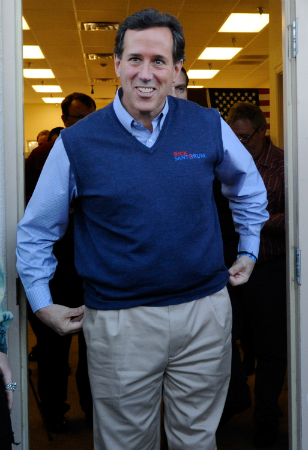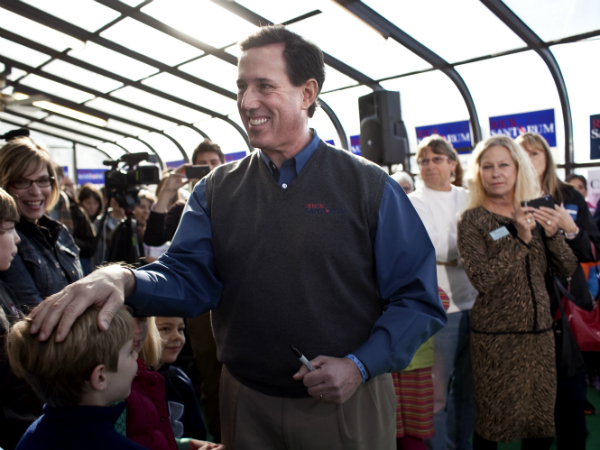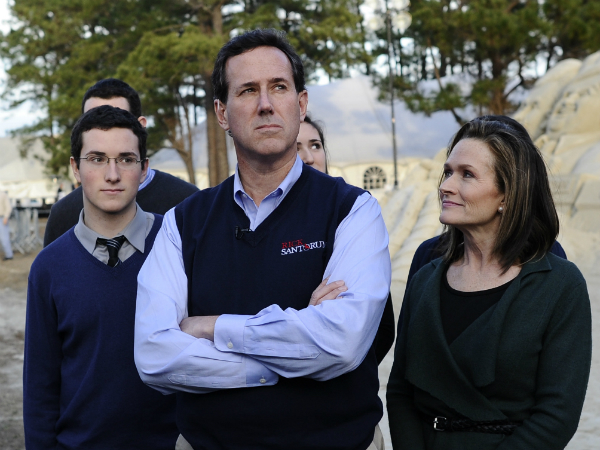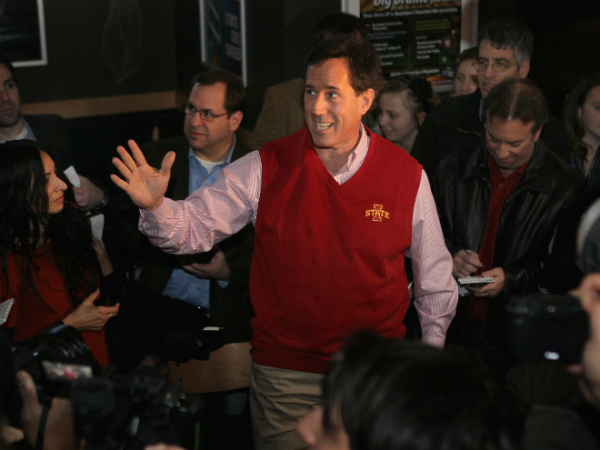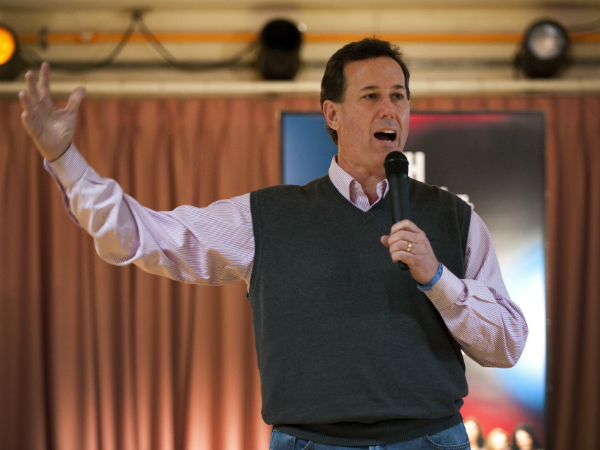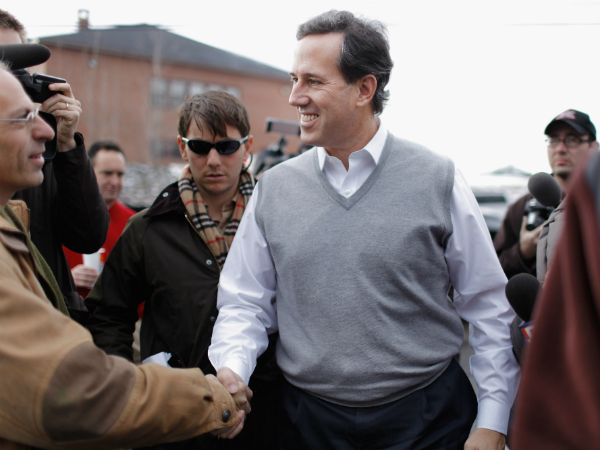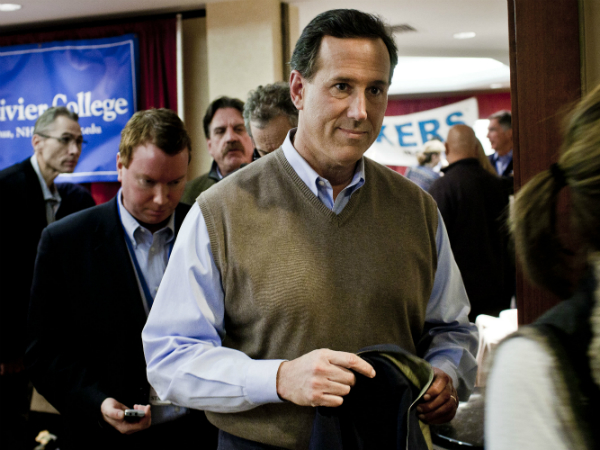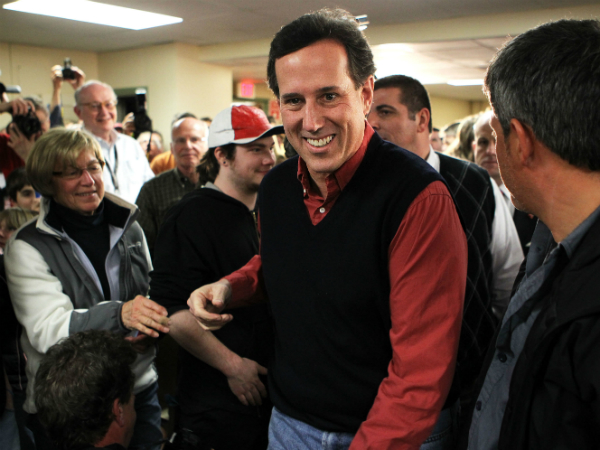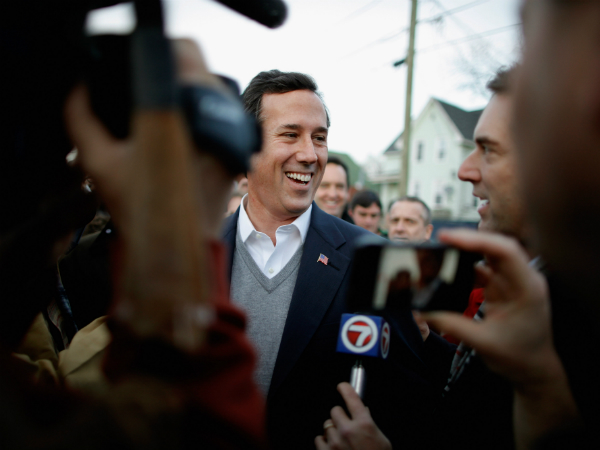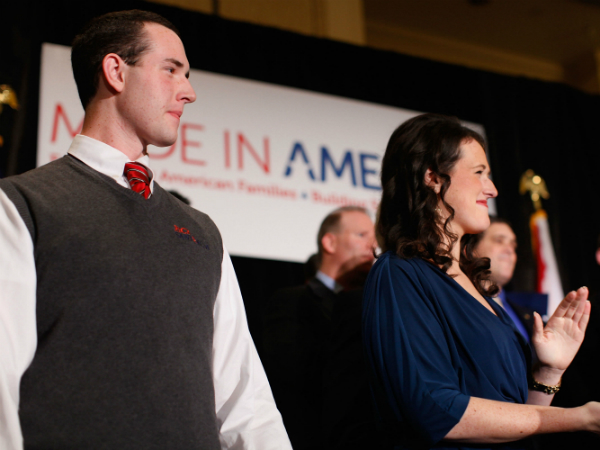Go Vest, Young Man
What does it mean that Rick Santorum wears a sweater vest?
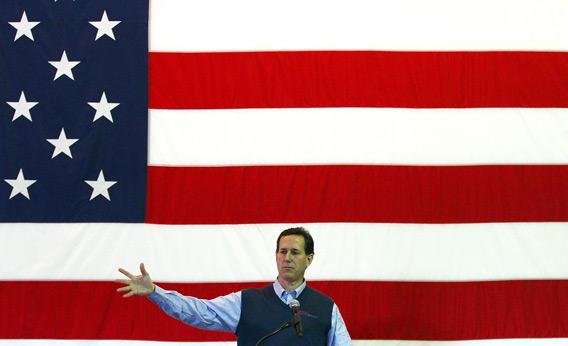
Mark Wilson/Getty Images.
Rick Santorum, the GOP presidential candidate from Pennsylvania, is known—as you’ve probably heard by now—for wearing a sweater vest. That sweater vest now has its own Twitter account, Facebook page, YouTube video, and fundraising campaign. The vest is everybody’s favorite fun fact about Santorum—but nobody seems to agree on what it’s actually doing for the politician (besides, perhaps, helping him to associate some new search terms with his blighted name). The range of responses to Santorum’s knitwear has been wide. Scarlett Johansson, who just declared the vest “so sad,” associates the look with her father. Griffin Perry, son of Rick Perry, tweeted that the vest reminded him of infamous sweater-vest-wearing football coach Jim Tressel. The Hartford Courant declared, perhaps prematurely, that Santorum had single-handedly transitioned the sweater vest from a neutral political status to a “right-wing vestment.” The New York Times positions the vest as grandfatherly; the LA Times prefers “avuncular.” Meanwhile, the Boston Herald went out on a limb and accused Santorum of “looking like a McDonald’s trainee.”
How did Santorum become a sweater-vest man? To understand his raiment, we must start with the origins of the garment itself. The Oxford English Dictionary lists the first use of “sweater” in 1882, in reference to the sleeve-having woolens used by rowers to encourage profuse sweating, and consequently, weight loss. By the turn of the century, the sweater, though still considered sportsman’s garb, had lost its perspiratory function and become a more standard jacket substitute. It seems to be at this point, or shortly thereafter, that the idea was first had to lop off the sleeves. In 1907, 14 members of Michigan’s football team were rewarded with an embroidered “M” sewn, for the first time, onto not regular sweaters, but sweater vests.
By the 1910s, sweater vests had become the sort of clothing a president might wear when he did outdoorsy things. In 1913 President Woodrow Wilson made news by wearing a sweater vest in place of a coat on a physician-prescribed walk following a bad cold, and again on a trip to a post office on Christmas Eve. Fifteen years later, Herbert Hoover also opted for the style, wearing a heavy double-breasted brown suit with a sweater vest on a fishing trip. By the time the ‘30s rolled around, sweater vests were standard in men’s suiting: During the Depression, suit manufacturers began to sell cheaper, vestless suits, in place of the three-piece standard. In 1939, the New York Times reported that manufacturers were introducing two-piece suits sold with a sweater vest in order to drive prices back up. The sweater vest was even popular with first lady Eleanor Roosevelt, who in 1934, wore a “sleeveless sweater” along with her tweeds.
The sweater vest has faded in and out of fashion for the past seven decades, gaining intermittent popularity with golfers, grandfathers, businessmen, and hipsters. Rick Santorum is far from the first public figure to claim the sweater vest as his signature style. Notable practitioners include Mike Ditka, coach of the Chicago Bears in the ‘80s; Dan Rather, who regularly wore a sweater vest on CBS Evening News in an effort to boost ratings; Jim Tressel, the famously disgraced coach of the Ohio State football team, known as “the Vest” for his sideline style; Rex Ryan, the coach of the New York Jets, whose black sweater vest also boasts its own Twitter account; former New Jersey Gov. Jon Corzine; and even Justin Timberlake.
You may notice a wide range here—the sweater vest has been proudly adopted by jocks, rich guys, guys who want to seem friendlier, and cool young men. Indeed, at first glance, the sweater vest seems riddled with contradiction. It lies at the intersection of practicality (it provides warmth to the core while leaving the arms unencumbered ) and frivolity (it is often used purely and impractically to jazz up an otherwise staid ensemble). The look is both boyish and grandfatherly, sporty and fusty, conservative and eccentric, old-fashioned and hip. These conflicting connotations emerge even more clearly when you look at the ways the sweater vest has been mobilized by various costume designers over the years: On Chandler Bing, the vest informs us that we’re looking at a lovable loser; on Ferris Bueller it reads as retro with a touch of punk; on Dirty Harry, the vest says rogue; on Steve Urkel it says nerd; worn with short sleeves and bulging biceps, the vest helps make Brad Pitt into a tough guy; the argyle version worn with Dockers tells us that Michael Bluth is a total square.
Why does the sweater vest have so many meanings? A plausible reason might be that men have few opportunities to distinguish themselves when dressing up; they must turn to things like tie clips or cufflinks or socks to demonstrate a bit of quirk and individuality. In fact, it may help most to think of the sweater vest as belonging to the same camp as the bow tie: both meek but deliberate cries for sartorial attention. This theory would explain why there are so many kinds of sweater-vest guys: It’s a way to individualize (or at least feel as though one is individualizing) all sorts of looks.
So what is Rick Santorum trying to broadcast about himself with his sweater vest? Which sweater vest paradigm does he fit into? It’s not totally clear. Writers have speculated that Santorum’s vest may represent an attempt to align himself with the common man. When Santorum wears vests embroidered with his campaign slogan, or other emblems—which makes him look like a guy wearing the schlubby swag from his office’s annual picnic—I can almost buy it. But when he wears unembellished vests—which he buys from Jos. A Banks, and occasionally Brooks Brothers—the look is more WASP than everyman. When he talks about his choice of clothing, Santorum—who gives the impression he doesn’t know whether this sweater-vest thing is going to backfire or make his campaign—doesn’t seem to have the firmest hold on what he’s doing. According to the Washington Post, Santorum has said that he wears the vest in order to appear more mature. But in other contexts, he positions the vest differently. Talking to CNN’s Erin Burnett, he offered a pun: “This is my second amendment vest: the right to bare arms,” On another occasion he told NPR that the wimpish sweater vest was his battle gear: “I am in my fatigues,” he said. “You, know, my flak jacket.” Personal style doesn’t seem to come into it at all, for Santorum, nor are the vests even flattering on his somewhat paunchy torso.
And so from Santorum we learn an important fact about sweater vests: Without a confident and sure wearer, the sweater vest—so long laden with so many conflicting associations and meanings—doesn’t really evoke anything at all. Think about who else is rocking the look these days: Besides out-to-pasture football coaches, sweater-vest devotees include Mad Men-obsessed slicksters and steampunk-style enthusiasts. All three groups wear their vests so unapologetically that more tentative forays seem awkward. Which means that the only thing worse for Santorum than tentatively wearing the sweater vest would be, even more tentatively, to stop.

